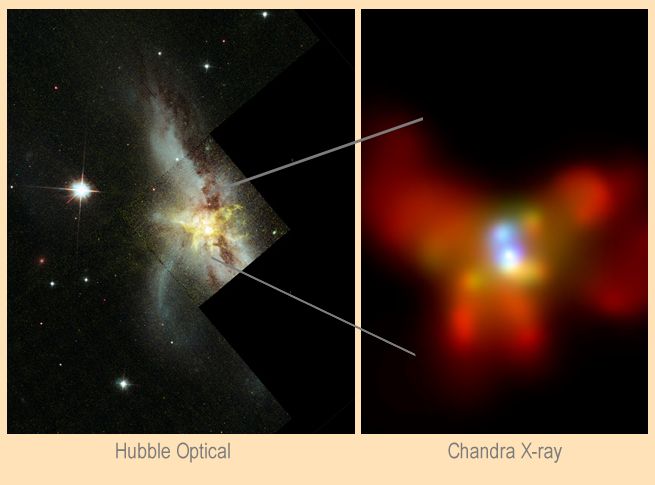APOD.pl: astronomiczne zdjęcie dnia
Codziennie nowy obraz lub zdjęcie naszego fascynującego Wszechświata
wraz
z krótkim objaśnieniem napisanym przez zawodowego astronoma.
Zobacz więcej!

Supermasywne czarne dziury NGC 6240
Źródło:
zakres optyczny: R. P. van der Marel i J. Gerssen
(STScI),
NASA;
zakres rentgenowski: S. Komossa i G. Hasinger
(MPE) et al.,
CXC,
Opis: Zdjęcie optyczne po lewej z Hubble'a pokazuje NGC 6240 w spazmach tytanicznej galaktyki - zderzenia galaktyk 400 milionów lat świetlnych od nas. Gdy rozgrywa się kosmiczna katastrofa, łączące się galaktyki wypluwają zniekształcone warkocze pływowe gwiazd, gazu i pyłu oraz przechodzą szaleńcze wybuchy powstawania gwiazd. Korzystając z obrazu rentgenowskiego, dostarczonego przez Obserwatorium Chandra do zajrzenia w jasne obszary centralne NGC 6240 astronomowie uważają, że dzięki wykryciu charakterystycznego promieniowania X z resztek międzygwiazdowych, opadających po spirali na czarne dziury odkryli po raz pierwszy, nie jedną, lecz dwie przeogromne krążące wokół siebie takie ciała. Na sztucznie pokolorowanym zbliżeniu po prawej dane rentgenowskie wyraźnie pokazują źródła czarnych dziur (zacienione na niebiesko), oddzielone od siebie o jakieś 3000 lat świetlnych. Teoria grawitacji Einsteina przewiduje, że taka para czarnych dziur musi zbliżać się po spirali do siebie, by po kilkuset milionach lat ostatecznie zlać się w pojedynczą, jeszcze masywniejszą czarną dziurę. W końcowych momentach łączące się supermasywne czarne dziury wytworzą niesamowicie potężny rozbłysk promieniowania grawitacyjnego.
Jutro: daleko, czy blisko
<
| Archiwum
| Lista tematyczna
| Szukaj
| Kalendarz
| Słownik
| Edukacja
| O APOD
| Forum
| >
Autorzy i wydawcy:
Robert Nemiroff
(MTU) &
Jerry Bonnell (UMCP)
NASA Official: Phillip Newman
Specific rights apply.
NASA Web
Privacy Policy and Important Notices
A service of:
ASD at
NASA /
GSFC
& Michigan Tech. U.